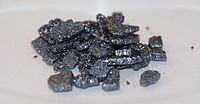
Photo from wikipedia
Atmospheric iodine cycling is of significance in climate change and environmental and health impacts. To better explore speciation transformation of atmospheric stable and radioactive iodine, an ultra-sensitive analytical method was… Click to show full abstract
Atmospheric iodine cycling is of significance in climate change and environmental and health impacts. To better explore speciation transformation of atmospheric stable and radioactive iodine, an ultra-sensitive analytical method was established for determination of 129I and 127I in particulate, gaseous inorganic, and gaseous organic species, which was conducted with a self-designed cascade sampling apparatus, followed by their separation with a pyrolysis system and accelerator mass spectrometry and ICP-MS measurements. Combustion protocols for three sampling matrices and NaOH concentration for iodine trapping were optimized to achieve a safe analytical procedure with a high chemical yield of iodine. Based on the lowest concentrations of 129I and 127I, a suitable activated carbon product for adsorption of gaseous organic iodine was carefully selected. The detection limits of the three species were 0.30-2.21 ng m-3 for 127I and 0.05-0.22 × 105 atoms m-3 for 129I. This newly established method was successfully applied to analyze the levels and species of 129I and 127I in ambinet air from Xi'an, China, from May to August, 2020. Gaseous organic iodine was found to be the dominant species of 127I and 129I, accounting for about half of total iodine, and gaseous inorganic iodine and particulate iodine accounted for one-quarter each during the whole sampling period. Speciation variation of 129I and 127I indicates that speciation transformation apparently occurred at the turn of spring and summer, mainly between particulate and gaseous organic iodine. This study has implications on delicate tracing of the atmospheric behavior of iodine with long-lived anthropogenic 129I.
Journal Title: Analytical chemistry
Year Published: 2022
Link to full text (if available)
Share on Social Media: Sign Up to like & get
recommendations!